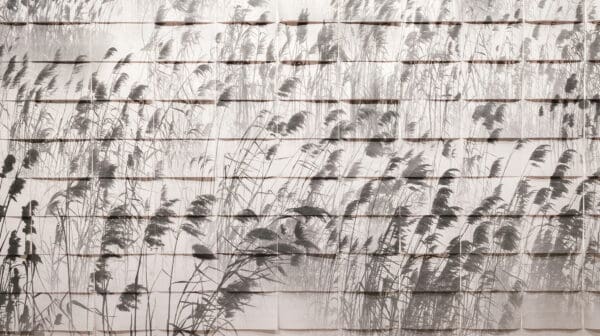
Poetics of Relation
Tender Comrade, currently on show at Sydney’s White Rabbit Gallery, creates a new vocabulary of queer kinship by reimagining the relationship between artworks, bodies and space.
Whoever decided to put Bob Ross’s TV series on Netflix deserves a promotion and a raise. Two series are currently available; the essential Bob Ross: Beauty is Everywhere, a master class in the late painter’s peerless painting technique, and his preferred subjects; and Chill With Bob Ross, a series dedicated to the hard-to-master subject of snow and mountain landscapes. While there are only a few art documentaries available on Netflix – one a [fake] documentary on Damien Hirst’s widely panned 2017 Venice show Treasures from the Wreck of the Unbelievable, another on Cai Guo-Qiang’s Sky Ladder fireworks – a series of instructional how-to-paint videos is a remarkable rarity.
Ross, who died in 1995 aged 52, ran his show The Joy of Painting on the US network PBS for 11 years from 1983 to 1994. He was essentially self-taught, having first encountered The Magic of Oil Paint, another instructional TV show hosted by expatriate German artist Bill Alexander, and he carefully copied Alexander’s wet-on-wet technique that allowed Ross to complete a painting in under 30 minutes. With some light editing, this turned out to be the ideal length for a TV show.
I had never heard of Ross when I first encountered his smiling face looking out from the ranks of recommended TV shows, but I am sure my reaction to him was typical of the reason his show is now so popular. Ross has a remarkable, soft speaking voice, and a fright of permed hair that sits atop an-always smiling face. His many eccentricities include his love of woodland creatures including squirrels, some of which he had hand-raised, and brought into the studio, and feature when a time-jump cutaway is needed. Ross has a raft of verbal eccentricities too, such as referring to his most famous landscape motif as “happy little trees”, or saying, as he adds in details, “Ok, let’s have some fun…”
Starting with his standard, pre-prepared canvas, Ross begins a painting and the names of the colours he’ll be using (rarely mixed, and used straight from the tube) scroll across the screen. His technique of creating a picture was relatively straight- forward: starting with paint for the sky, then adding in a mountain, adding a reflective lake, then trees and small details, and finishing off with some trademark Ross motifs, notably an often not-to-scale forest cabin… and voila, a complete picture.
Rather, they are a collection of clichés that are executed with the hand of experience – some estimate that Ross produced as many as 30,000 pictures in under 20 years. Although absurdly kitsch, these paintings are not easy to execute. Ross’s viewers would often send in snapshots of their own attempts at his style, and most of them didn’t quite match the master. He would encourage his followers with the kind words of an ex-military drill instructor turned forest hippy, a man who vowed that when he got out of the US Air Force, he would never raise his voice in anger again.
My daughter once asked, since her father is allegedly an art critic, whether Ross’s paintings were good or bad. I tried to explain that at a certain point in the artist’s process that the paintings are actually good – if he could just stop before overloading the picture with ‘detail’ he’d have a kind of postmodern quotation of a ‘bad painting’ – but he couldn’t resist ruining a gorgeous minimal composition with too many trees or a waterfall or some rocks by the lake or whatever – and they would become genuine bad paintings.
Ross belongs to the tradition of amateur painters who infinitely repeat the pictorial formula of American Romantic artists such as Thomas Cole and Alfred Bierstadt, taking an already familiar bag of painterly tricks and reducing an epic view of nature, and man’s place in the cosmos, to what you can knock out in half an hour. Like his fellow American painter Thomas Kinkade, Ross produced a kind of ambient idea of what art should look like for an uneducated audience, a series of literal gestures that produce an effect. It might not be the real world, but it might even be better than that.
But unlike Hirst, Ross has achieved pop culture immortality, now his face and art can be found on a series of fun t-shirts, caps and mugs. You can buy his instructional videos, books, brushes and paints, and Ross was the subject of a [real] 2011 documentary. Perhaps the ultimate accolade was when he was parodied in the first trailer for Deadpool 2. Yet beyond all that, his show is hypnotic – no matter how much your mind works against it, his still glades, distant mountains and arctic lakes beckon the viewer – come and wander in this perfect world.